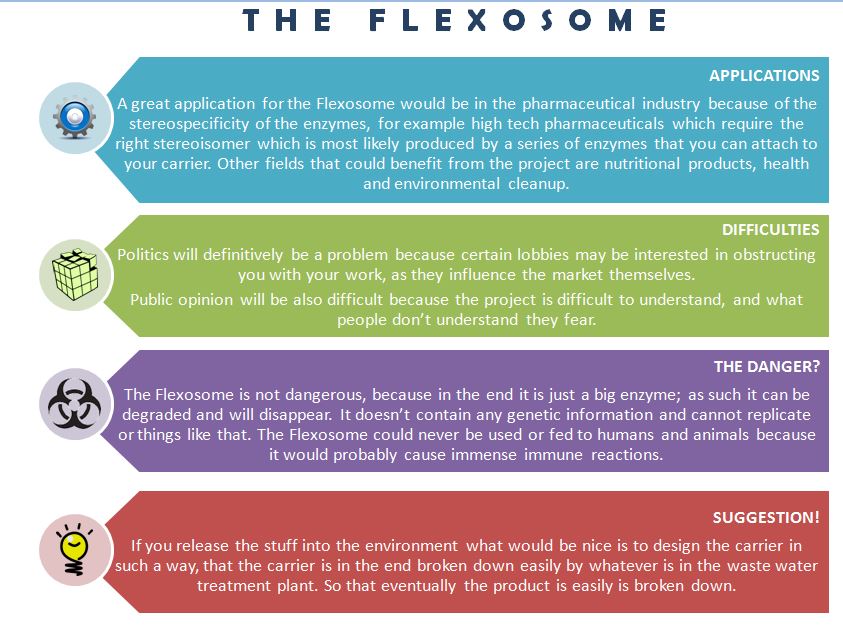Difference between revisions of "Team:Goettingen/Practices"
| Line 43: | Line 43: | ||
<strong>To remember:</strong> Dr. Volker von Hoyningen-Huene helped us to realise that one of the main points related to the implementation of this kind of synthetic biology project is the public opinion. It is fundamental to explain the project in a simple and accessible way, so non specialised people can understand it and therefore support it without the fear that comes from misinformation. | <strong>To remember:</strong> Dr. Volker von Hoyningen-Huene helped us to realise that one of the main points related to the implementation of this kind of synthetic biology project is the public opinion. It is fundamental to explain the project in a simple and accessible way, so non specialised people can understand it and therefore support it without the fear that comes from misinformation. | ||
</p> | </p> | ||
| + | |||
| + | <h2>Product Design<h2> | ||
| + | <p> If the flexosome could pass the proof of principle stage and be further developed into a commercially viable product, we would provide it in form of a kit. | ||
| + | The kit would work like a building set containing: | ||
| + | 1.) purified scaffoldin | ||
| + | 2.) Plasmids containing each dockerin (currently a max. of 4) | ||
| + | All the user would have to do is insert the enzyme of choice in the plasmid with the dockerin, express the construct and mix together with the scaffoldin. | ||
| + | Apply to substrate of choice. | ||
| + | <br> | ||
| + | Voilà! A custom made flexosome! | ||
| + | |||
| + | Future additions and developments: | ||
| + | The kit could contain columns with cohesin coated beads, allowing the user to remove the flexosome from their product with the extra dockerin domain connected to the end of the flexosome.By filtering the working solution through these columns, the flexosomes would adhere to the beads. This would provide a simple purification step once the flexosome has done its work. | ||
</html> | </html> | ||
Revision as of 21:00, 18 September 2015
Human Practices
For our human practices we wanted to think about the implications associated with our Flexosome tool. We consulted Dr. Volker von Hoyningen-Huene about his professional perspective on our project. During the interview we talked about synthetic biology, genetically modified organisms (GMOs) and a scenario with the Flexosome as an optimized product.
SYNTHETIC BIOLOGY
... is to construct new biological features from basic components, even if they are artificial components, such as reconstructed genetic information which is then expressed and produced as completely new functions.
GMOs
Any organism that has its genetic material altered by human influence. Not through breeding and selection but through molecular biology. They can be applied in industry, fuel, environment, health, energy and in the elaboration of nutritional products for example.
GMO’s worst case scenario
A worst case scenario can be found in science fiction films. I don’t think such a thing has ever happened. In a worst case scenario somebody would use your system in order to produce a very efficient poison as a misuse for war purposes. Such a complex protein could be put into water of a city and therefore cause damage without causing realisations.
GMOs perception
Publicly they have a bad reputation, but personally I see it more differentiated. I see the concern in the public of depending very strongly on individual firms like, e.g. Monsanto, in the total exploitation for commercial means rather than applications that pursues the society as a whole.
To remember: Dr. Volker von Hoyningen-Huene helped us to realise that one of the main points related to the implementation of this kind of synthetic biology project is the public opinion. It is fundamental to explain the project in a simple and accessible way, so non specialised people can understand it and therefore support it without the fear that comes from misinformation.
Product Design
If the flexosome could pass the proof of principle stage and be further developed into a commercially viable product, we would provide it in form of a kit.
The kit would work like a building set containing:
1.) purified scaffoldin
2.) Plasmids containing each dockerin (currently a max. of 4)
All the user would have to do is insert the enzyme of choice in the plasmid with the dockerin, express the construct and mix together with the scaffoldin.
Apply to substrate of choice.
Voilà! A custom made flexosome!
Future additions and developments:
The kit could contain columns with cohesin coated beads, allowing the user to remove the flexosome from their product with the extra dockerin domain connected to the end of the flexosome.By filtering the working solution through these columns, the flexosomes would adhere to the beads. This would provide a simple purification step once the flexosome has done its work.
